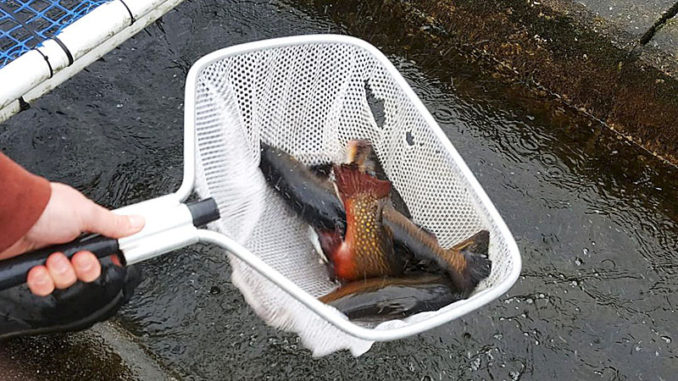
Stocked trout are the cornerstone of fishing in the Carolinas
Stocked trout are the backbone of trout fishing programs in North Carolina and South Carolina. Stocking provides ample fishing opportunities for anglers of all skill levels.
Beginning in February in South Carolina and in March in North Carolina, state agencies stock hatchery-supported waters with more than a million brook, brown and rainbow trout. Few restrictions apply. Limits are five trout per day in South Carolina and seven in North Carolina. Anglers may fish with hook and line, on live or artificial bait, using single or treble hooks.
Hatchery-supported streams in North Carolina close down for stocking at the end of February. They reopen to fishing the first Saturday in April. That will be April 6 this year. South Carolina’s hatchery supported streams do not close.
In North Carolina, contains more than 1,000 miles of streams and several small lakes in the western section of the state which are designated as hatchery-supported waters. South Carolina hatchery-supported waters are in Greenville, Oconee and Pickens counties and the tailwaters of Lake Hartwell and Lake Murray.
Specially equipped trucks carry the trout, which are stocked by hand, except in the wild sections of the Chattooga River. Stocking trucks cannot reach here. So five-inch fingerlings, approximately 25,000 trout, are stocked by helicopters.
Stocking sizes
Most South Carolina streams are stocked with trout 9 inches or longer. In a few select streams, the minimum stocking size is 12 inches.
North Carolina stocks its streams with 10-inch trout and releases an unspecified number of fish that exceed 14 inches “just to make the fishing interesting,” one hatchery official said.
South Carolina’s Walhallah Hatchery in Mountain Rest raises trout for the Palmetto State’s hatchery-supported waters. North Carolina’s fish are raised at four coldwater hatcheries: one in Transylvania County and three in McDowell County.
The Bobby Setzer Hatchery in the Pisgah National Forest near Brevard provides the bulk of trout for the western North Carolina counties. It produces close to 1.8 million per year, counting fry and adult trout. Sixteen outside raceways hold the trout. The raceways are covered with wire mesh to prevent predation by herons, otters and other predators.
Trout for stocking are produced using similar methods at the Walhallah hatchery and at the other three North Carolina hatcheries.
Biologists monitor the brood trout to catch them at the peak of their spawning cycle. Females are “milked” of their eggs, which are fertilized with the sperm of male trout. Fertilized eggs are placed in incubators until they hatch.
After they hatch, the nascent trout form egg sacs, which provide their only nutrition. When the egg sacs are emptied, biologists move trout to inside raceways. They feed the fish with high-protein, commercial feed. After they reach fingerling stage, approximately 4 inches, they move to outside raceways until they reach stocking size. The entire process from fertilized egg to adult trout takes between 10 and 14 months.
Sterile stockers
Early in the egg-to-fingerling stages trout are sterilized to prevent them from breeding with wild or native trout and disrupting genetic cycles. Sterilization also speeds growth and maturation.
North Carolina stocks its streams monthly or weekly, depending on angler pressure. Stockings continue until summer when streams, especially in lower elevations, are too warm or too low to sustain high numbers of trout.
The March stockings in North Carolina give trout ample time to spread out in streams, providing a more sporting type of fishing. Monthly and weekly stockings, however, do not give trout adequate time to disperse. And anglers who follow stocking times and places can deplete stocked fish in a manner of minutes. It’s legal, if they obey limits, but just a tad unethical.
Adam Moticak, supervisor of the Bobby Setzer Hatchery, said anglers catch 85% of stocked fish.
Moticak said the standard formula for stocking streams is 40% brook, 40% rainbow, and 20% brown trout. The formula at Setzer Hatchery is 40% brook, 40% brown, and 20% rainbow. Because of low pH conditions, the Setzer Hatchery cannot maintain high numbers of rainbow. Brook and brown trout are not affected.


Be the first to comment